Archive for the ‘art installation’ Category
The Essex Street Market Recordings 2
Ramona Rodriguez of Luis Meat Market in the Essex Street Market sells a prepared pork for the holidays. This is the recipe that she shared with me when I was soliciting recipes from the vendors – “El Pernil Adobado”. Click the play button below to listen to Ramona’s preparation.
Listen to the full collection of recordings.
The Essex Street Market Recordings

Proposed work “Recetas y Gangas” audio montage of vendors projected onto the street through a bullhorn mounted on the facade of the Essex Street Market
Commonly street markets around the world have both an outdoor and indoor space. The perimeters of the market may extend on to the street to invite pedestrians in to the market. Rather than walls, street markets may present large openings and awnings to create an arcade where people are at once outside and inside. The Essex Street Market in the Lower East Side of New York City does not have a side walk extension beyond sandwich boards and signage outside its brick wall. The Essex Street Market facade does not even present pedestrian level windows for those outside to peer in to the interior. The facade is rather an uninviting brick facade, perhaps a planned institutional barrier that Mayor La Guardia desired as he sought to take cart vendors off the sidewalk in an effort to clean up the streets from obstacles and noise. For the exhibition “Lettuce, Artichokes, Red Beets, Mangoes, Broccoli, Honey and Nutmeg: The Essex Street Market as Collaborator” at Cuchifritos curated by Nicolás Dumit Estévez Raful , I have sought to extend the Essex Street Market on to the sidewalk through sound.
There is a long history of market vendors announcing, singing or chanting their goods to the public. On Essex Street before cart vendors were moved off the street and into the market, they would call out their goods, hoping to attract buyers. I imagine that when the market first opened this practice continued. Today, walk through a traditional Latin American market and you will hear various products sung in to the air. To develop my project, I solicited vendors to vocalize their products and the more performative, the better. Only two vendors played along, one eagerly – Rosella Albanese from Pain d’Avignon and another through a bit of coaxing – Yanivis Rodriguez of Luna Brothers. You may listen to each of their recordings below.
Yanivis Rodriguez, Luna Brothers
Rosella Albanese, Pain d’Avignon
When I was trying to talk Yanivis into the recording while she worked the register, a shopper began to tell me about her recipes for preparing yams. It was an older Dominican woman, perhaps in her 60s who after describing her recipe, told me about the many health benefits of yams.
As I was having a difficult time convincing vendors to sing or chant their goods, I decided to request a recipe from them. This turned out effective as I’ve collected several recipes from vendors and customers. Over the next few weeks, I will describe the interactions with the subjects and you may listen to the shared recipe. The final piece is an audio montage that captures a portrait of the Essex Street Market through the voices of vendors and customers alike all recorded within the market. The audio montage is titled “Recetas y Gangas” (Recipes and Deals) and is available online. And please check out the show at Cuchifritos in the Essex Street Market opening on February 22nd, 2016.
Carlos Aguirre at the Museum of Modern Art, Mexico City
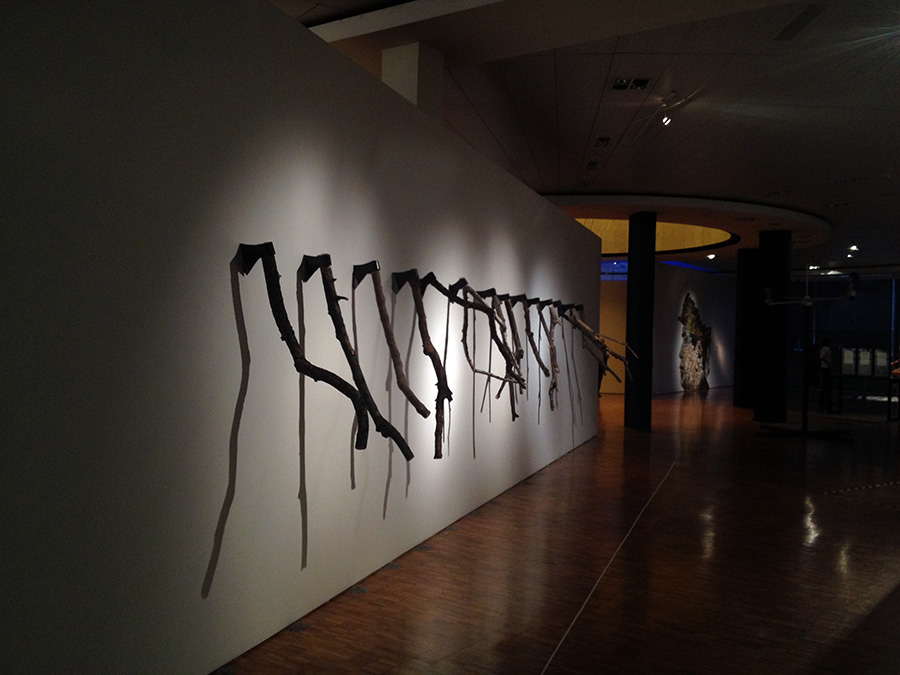
Between the Museo de Arte Moderno and Museo Universitario Arte Contemporanea (MUAC) there was a great deal of Carlos Aguirre (Acapulco, Mexico 1948) to take in this past month in Mexico City. “Zona de Riesgo” was the retrospective of the artist’s work from 1979 to 2014 installed at Mexico City’s Museum of Modern Art. The show was excellent and an amazing overview of an incredibly active artist. In general the exhibition is dark, even macabre as Aguirre appears to be driven by the violence of Mexico from the execution of criminals to excessive contamination.
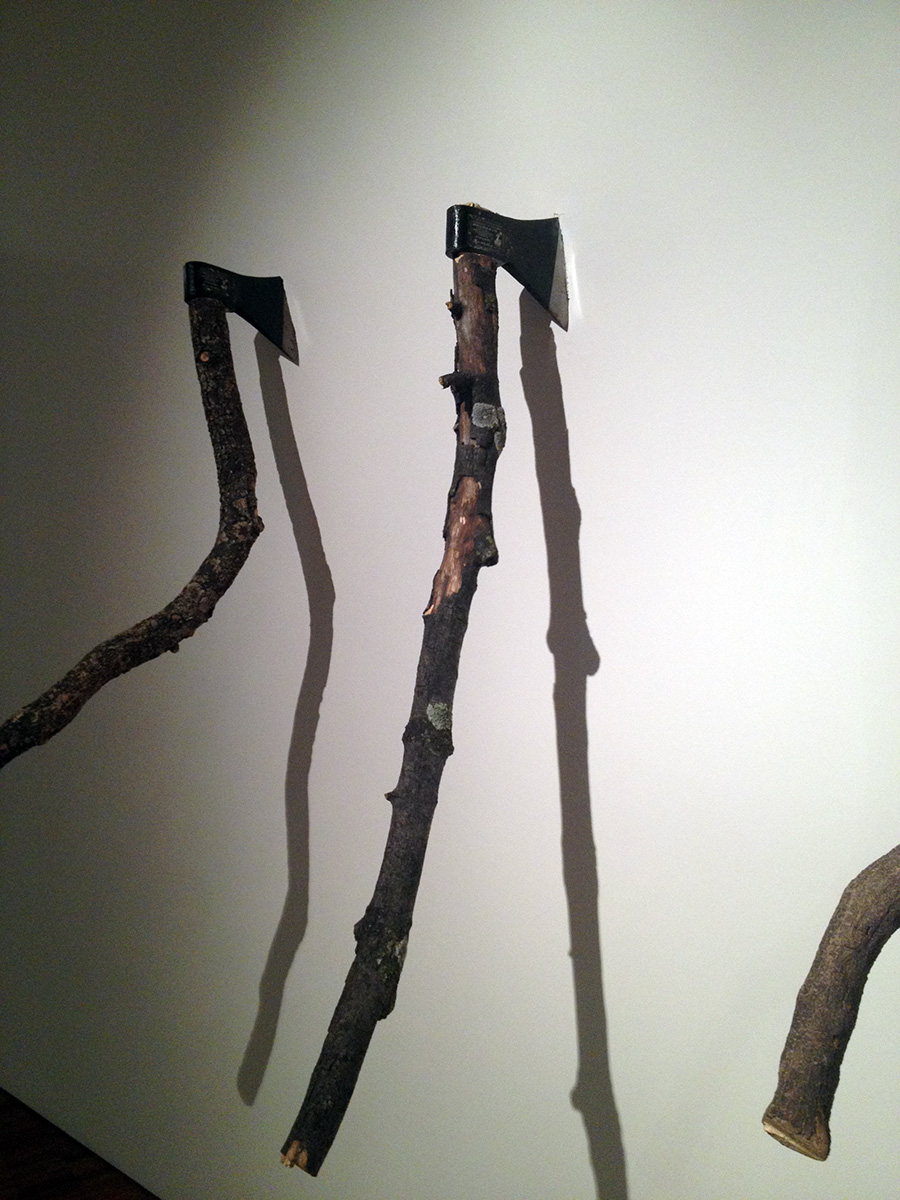
Upon entering the multi-gallery exhibition, one is greeted by a line of axes cleaved into a white wall. The blades of the axes are mounted on to branches, a powerful transformation of the ax that reminds the viewer of the violent nature of deforestation. In the early 1990s, Aguirre visualizes environmental impact with objects that may not be ignored such as blackened human lungs split open and cast in clear material hanging over a box filled with carbon.
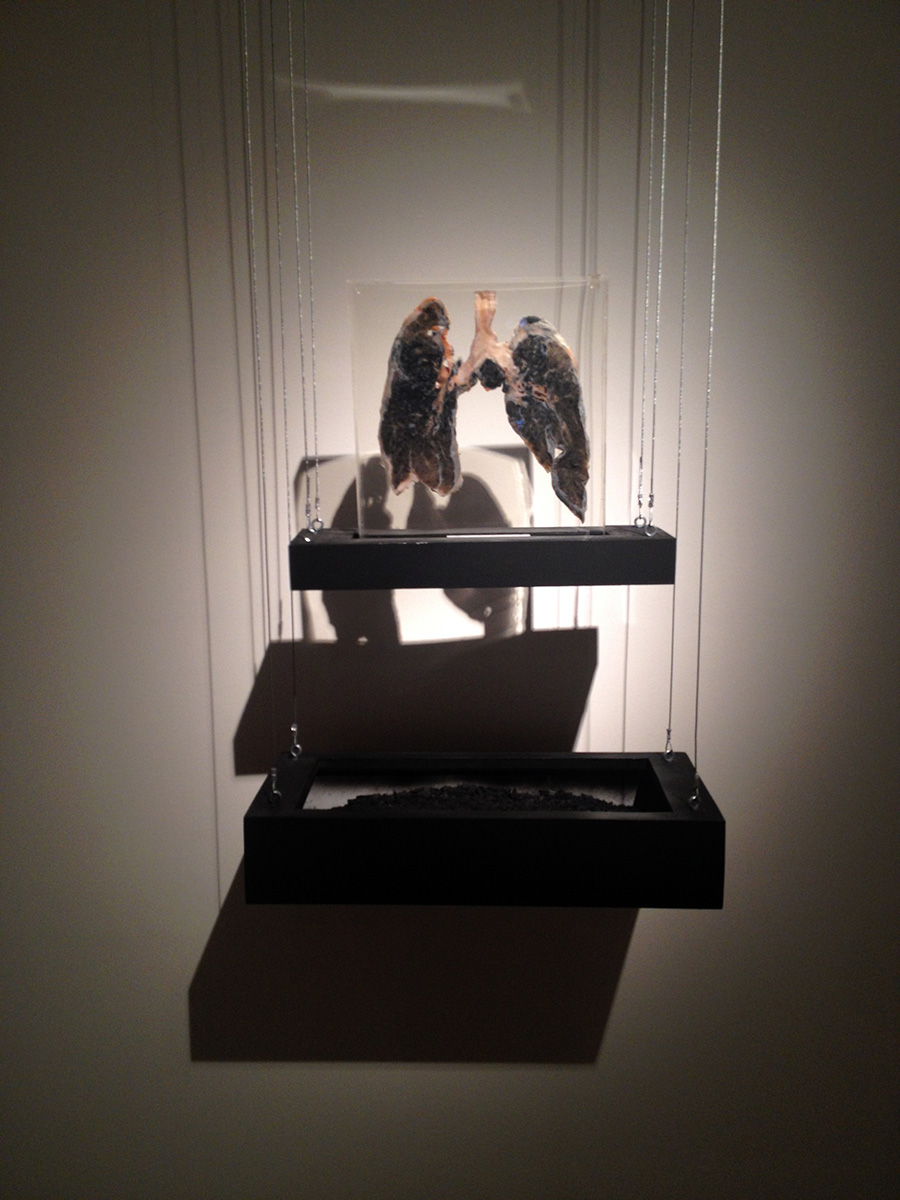
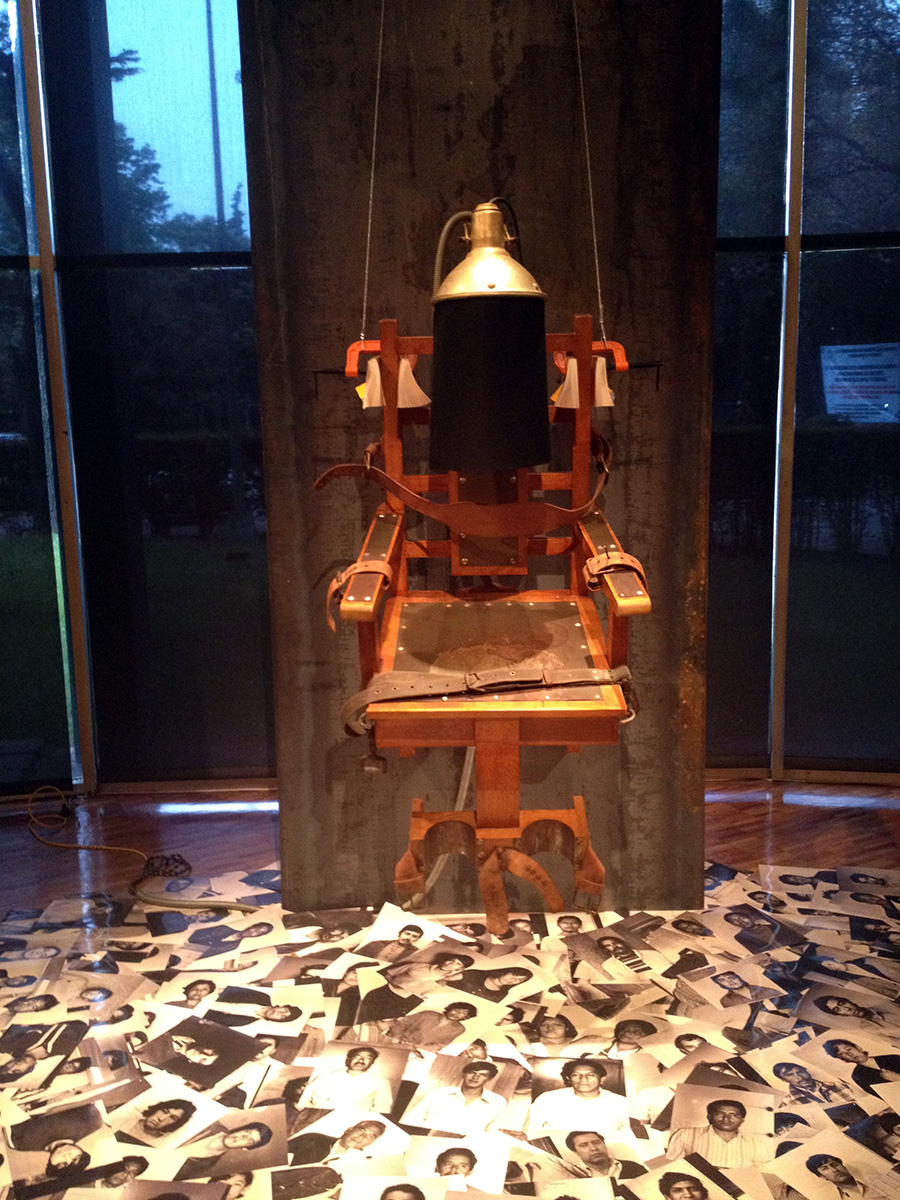
In the next gallery hangs an electric chair and below it the portraits of those executed. Near by is “Los olvidados” (1990), a giant portrait of a man in profile constructed from work gloves used by laborers.
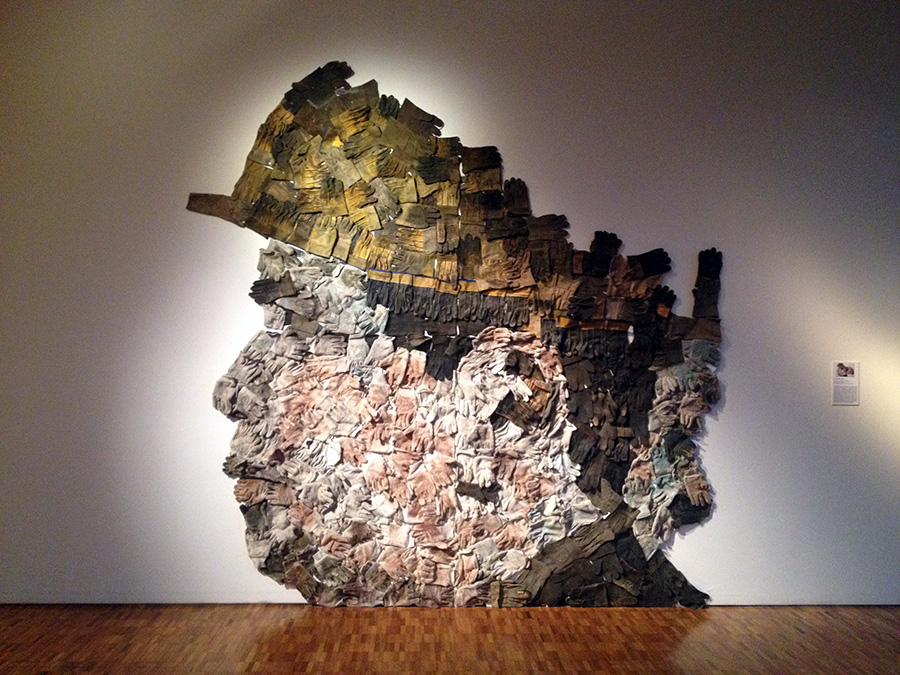
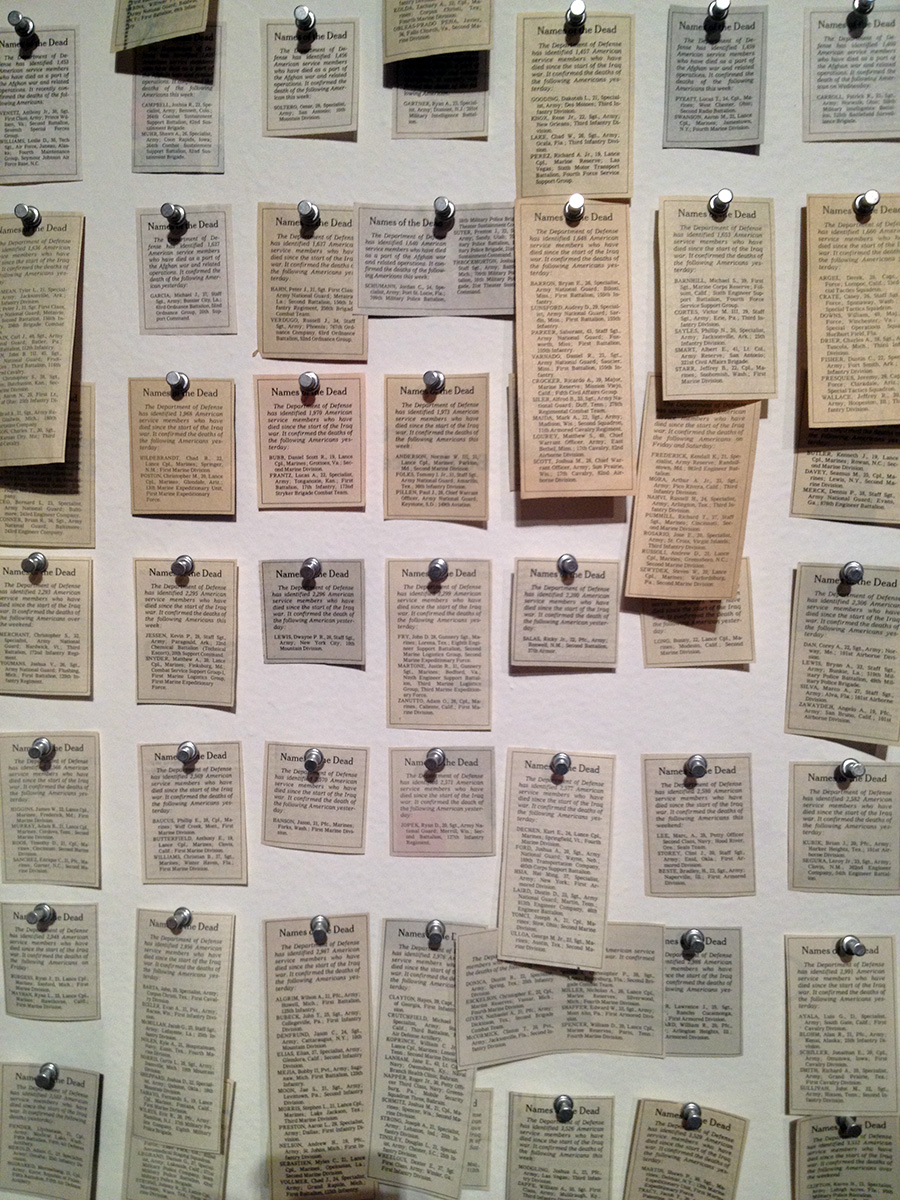
As I continued through the exhibition, I was drawn to a grid of small newsprint cutouts pinned to a wall. It was “Name of Dead” 1139 obituaries carefully cut out and posted to the gallery wall. The various galleries are joined by a large circular and domed area where “Dialectica, inteligencia vs. poder” (1995) is suspended. The piece is composed of many fire extinguishers hanging at various heights and at the center hanging at the end of a metal bar are a human brain and a small bust of Gustavo Díaz Ordaz, the president during the Tlatelolco massacre of 1968 when hundreds of unarmed protestors were shot.
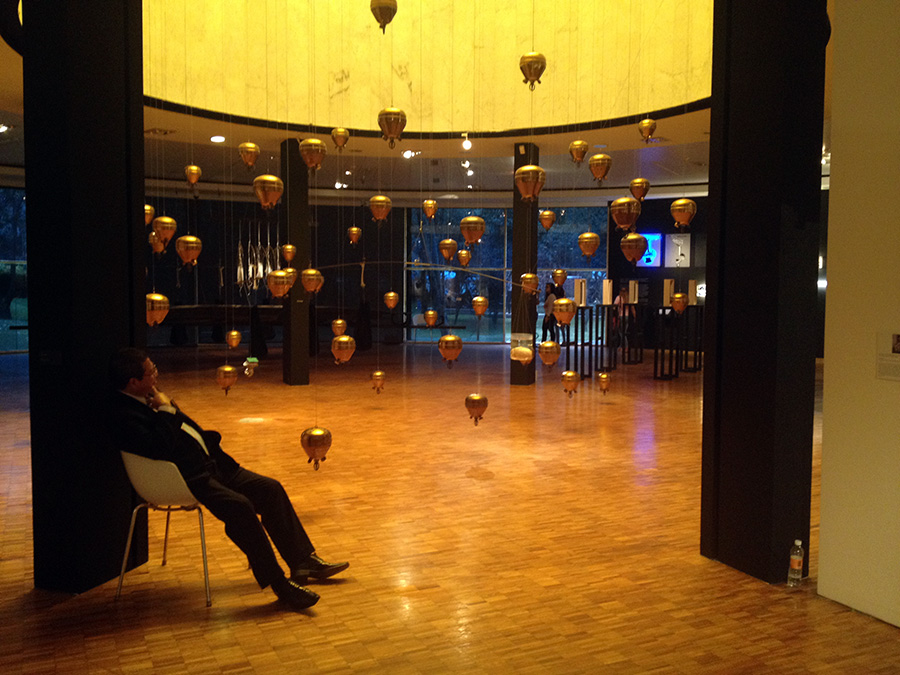
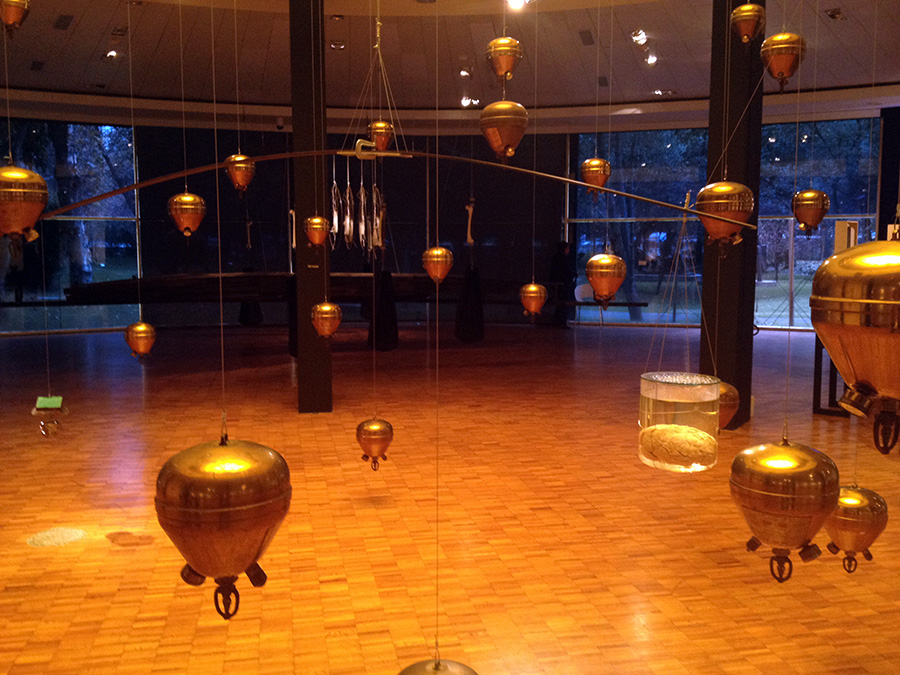
Beyond “Dialectica, inteligencia vs. poder” lies a dirt rectangle upon the floor and above the dirt are many shovels placed upon a wooden structure. When the dirt is inspected one will find human teeth and bones as well as corn.
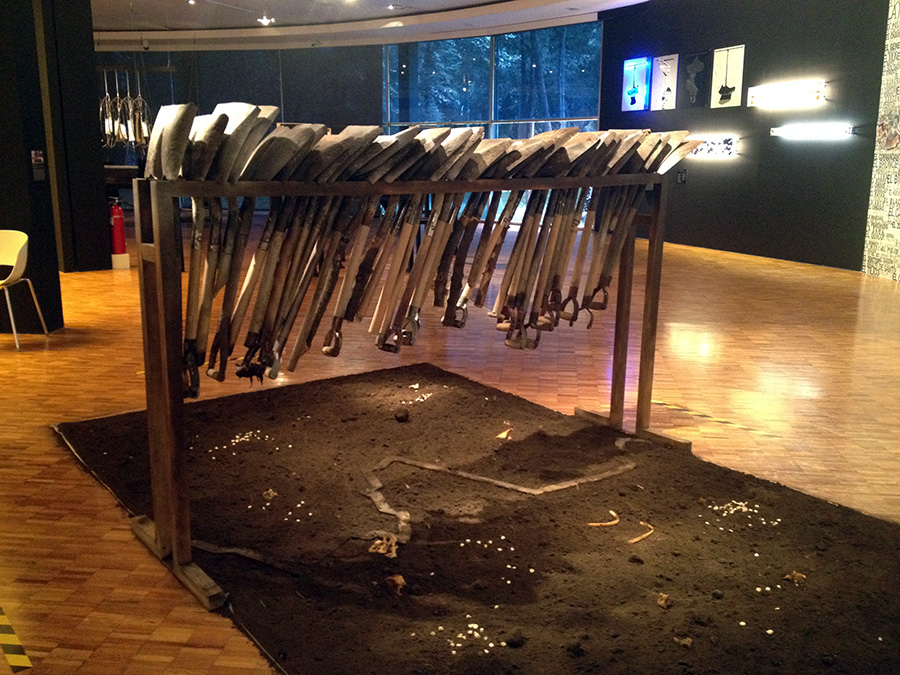
One of the final pieces in the exhibition is a black priest’s robe embroidered with 200 names of victims sexually abused by priests when the victims were children.
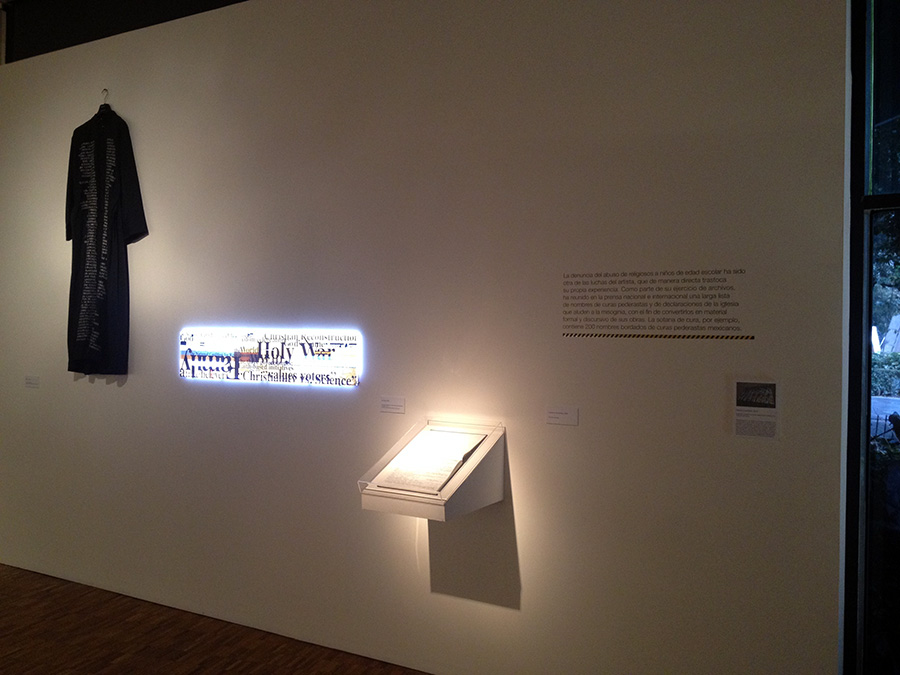
There is not much nuance in the visual metaphors constructed by Carlos Aguirre, instead the work is direct and confrontational. He makes it difficult to ignore the dark realities of our culture, Mexico’s reality is one giant risk zone or zona de riesgo.
At MUAC there is a large retrospective of the artist collective Grupo Proceso Pentágono in which Carlos Aguirre played a role during a period of time. For this exhibition, Aguirre rejoined the group to create a critique of the 43 missing students who disappeared on the night of September 26th 2014.
“una geographia de ser” at Transitio_MX
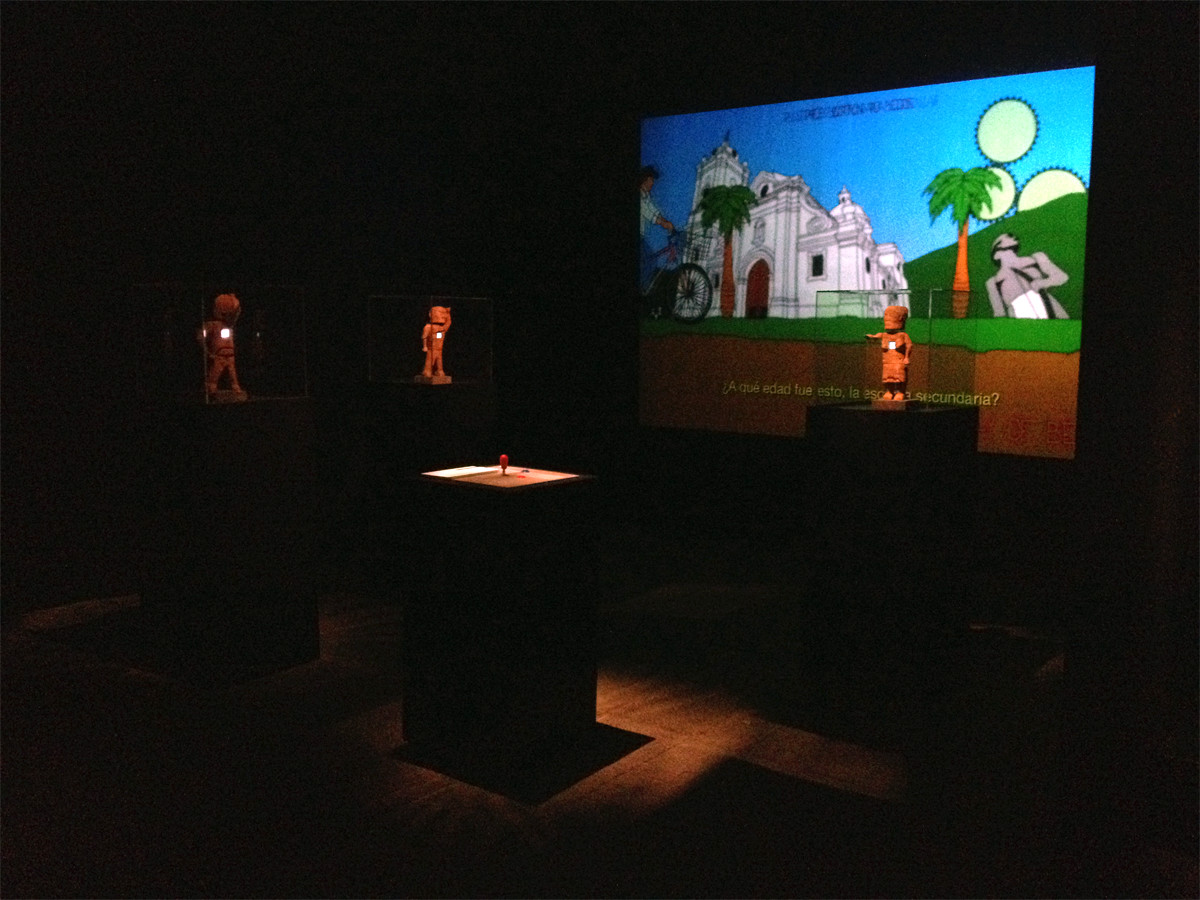
Opening this Friday, September 25th 2015 “a geography of being: una geografia de ser” as part of Transitio_MX, Festival de Artes Electrónicas y Video, on view through 4 October, National Center of the Arts, Mexico City. The festival consists of various exhibitions, workshops, lectures and discussions. “a geography of being: una geografia de ser” is part of the exhibition “play ? game [play[not]game] //más allá de la caja negra (beyond the black box)” curated by Brian Mackern.
Since 2005, The National Council for Culture and Arts, through the National Center of Arts and the Multimedia Center, has been organizing the Electronic Arts and Video Festival, Transitio_MX, which has become Mexico’s most important platform for expression and contemporary practices in artistic creation that are linked to technology, as well as hybrid productions created by the merge of art, science, technology and humanities.
Play “a geography of being: una geografia de ser” online or with Spanish subtitles.
a geography of being is an interactive art installation that reflects upon the dynamics of the undocumented immigrant population in the United States, specifically in relation to undocumented youth. The installation consists of wooden kinetic sculptures with animated displays titled “Undocumented Drones” and a video game that places the player in the role of an undocumented youth that must face several challenges in the search for self-determination beyond the imposed constraints of citizenry. The visitor to the installation plays the game, the “Undocumented Drones” react to game play and may help the player along. The installation was on view at The New York Hall of Science from October 27, 2012 to January 13th, 2013 as part of the exhibition ReGeneration.
The installation has been produced with the help of Cesar and Vishal, two young men who immigrated to the United States as young children. Their experiences and observations helped develop the game and determined the final goal of the game – self-determination. The conversations with Vishal and Cesar were incredibly revealing and extended the question of citizenry beyond civil status or politics to personal psychological realities. These are personal realities that effect friendships, romantic relationships as well as day to day life. For these two young men, a defining role has been that of activists and forming a powerful community in the New York State Youth Leadership Council.
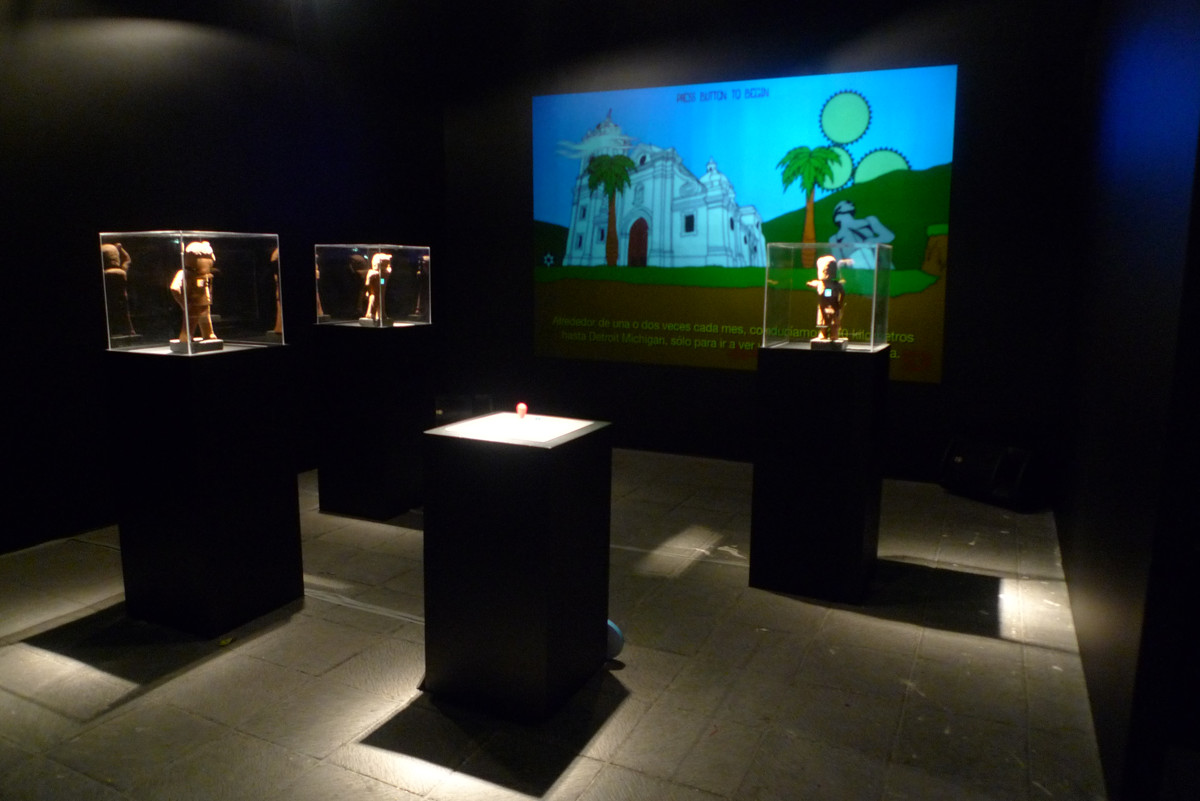
Transitio_MX 06 Cambios Compartidos Opens 9/25
This year’s installation of Mexico City’s Festival of Electronic Arts and Video Transitio_MX 06 is titled “Cambios Compartidos” (“Shared Changes”) and opens Friday September 25th and runs through October 4th at the National Center of the Arts. “a geography of being : una geografia de ser” will be on view and the game is available to play online.
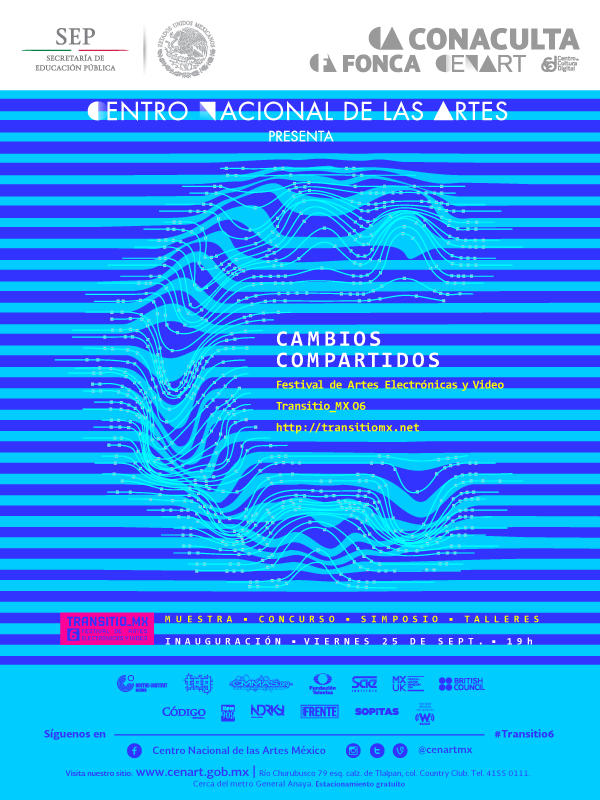
FAILE at the Brooklyn Museum
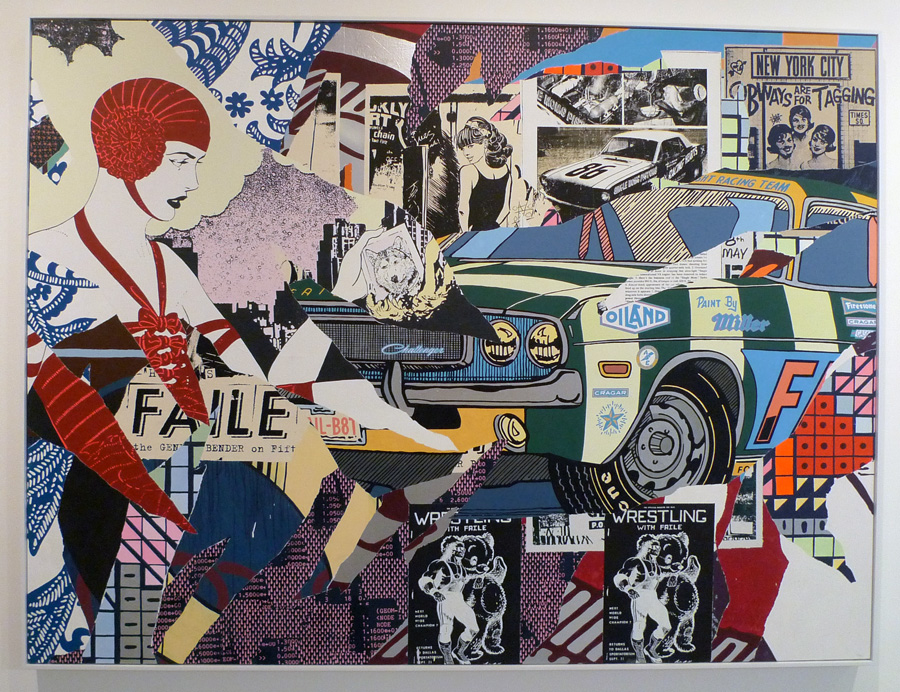
“FAILE: Savage/Sacred Young Minds” at the Brooklyn Museum is the epitome of hipster art. It’s fun, participatory, ambitious, cool, but lacks substance. I enjoyed the work visually and appreciated the nod to rock posters and arcades, but as with the video games presented, the work is not layered or nuanced or provocative. (The video games are worth playing for only a minute as they are more so about hip graphics and chirps, than game play or social commentary as much of game art is.)
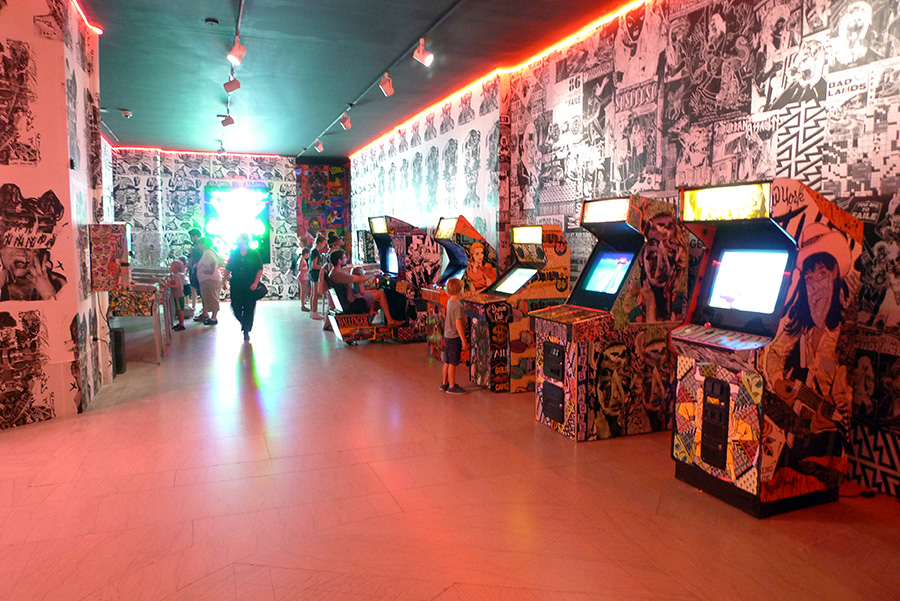
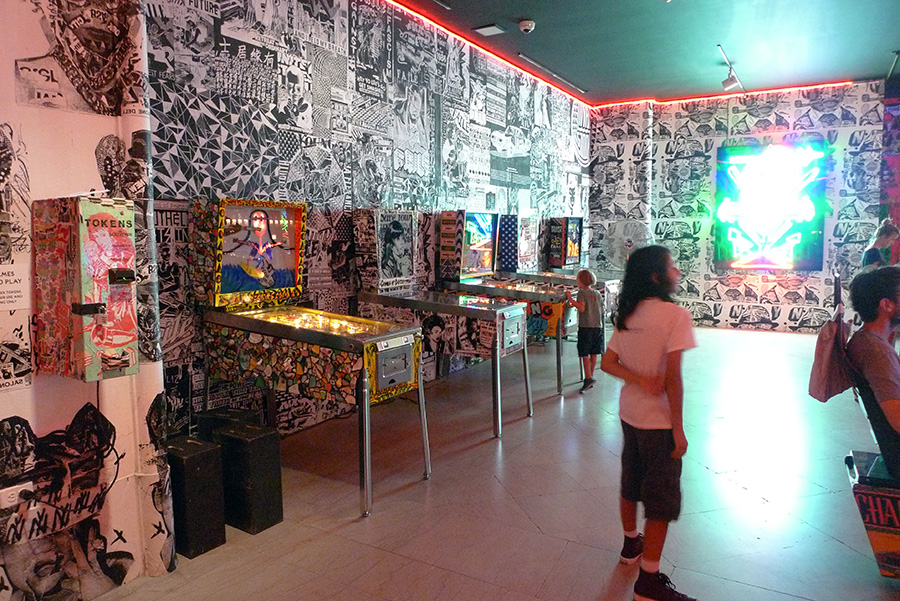
“Temple,” a sculptural structure reminiscent of a classical temple or mausoleum in ruin is the most striking work. The ceramic and iron work is highly detailed. At the rear center where one might find an alter is a male torso with a horse head wearing goggles and an oxygen tank. It is an end-of-times idol. An ironic creature more foreboding than an object of worship. The beautifully detailed work is unfortunately riddled with kitsch and self-labeling as the name “FAILE” is embedded in the work. I suppose that the kitsch as well as the identity stamped throughout the work is a critique of consumer culture. Unfortunately the identity FAILE is so prevalent in the work that the art itself becomes objects of consumer culture, hip, cool to look at, but one walks away with nothing. Perhaps that is the goal.
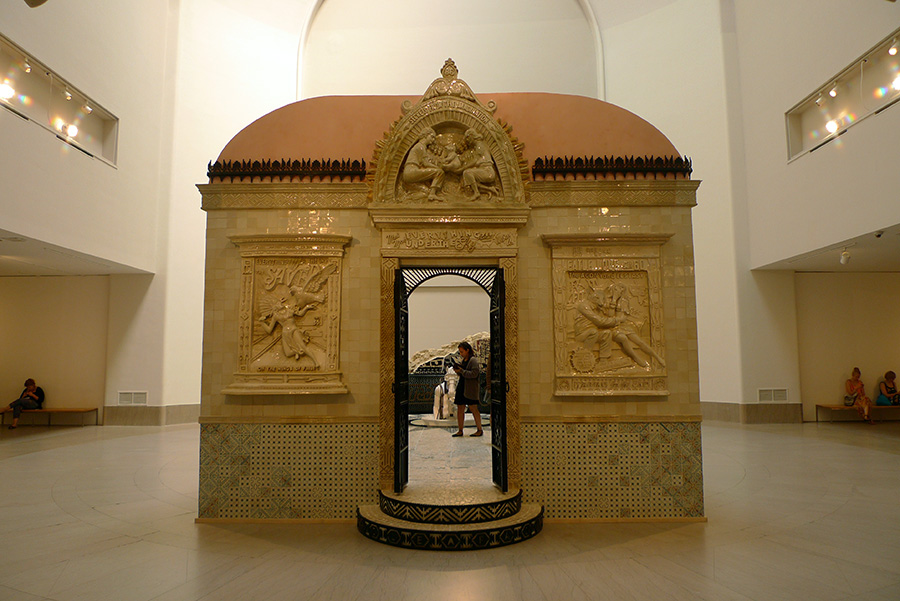
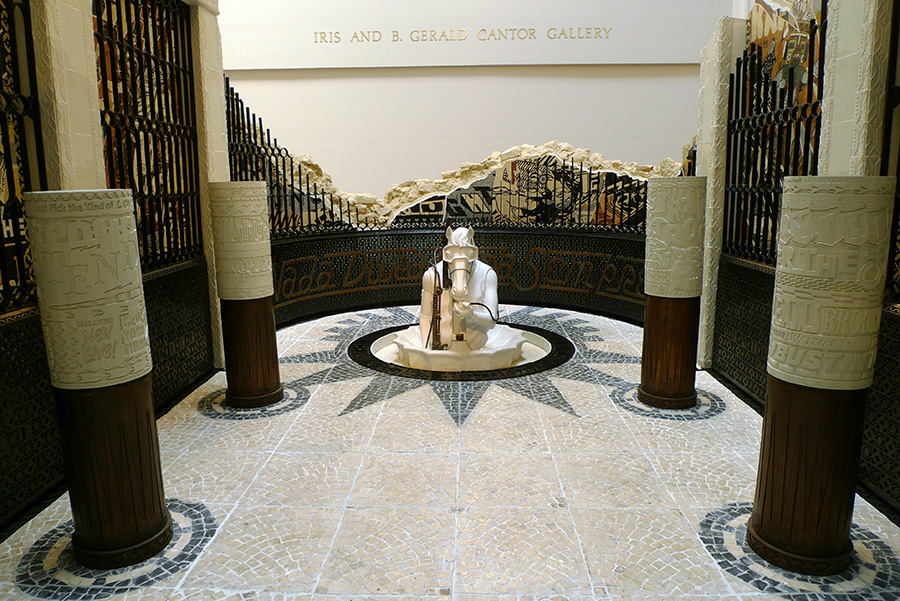
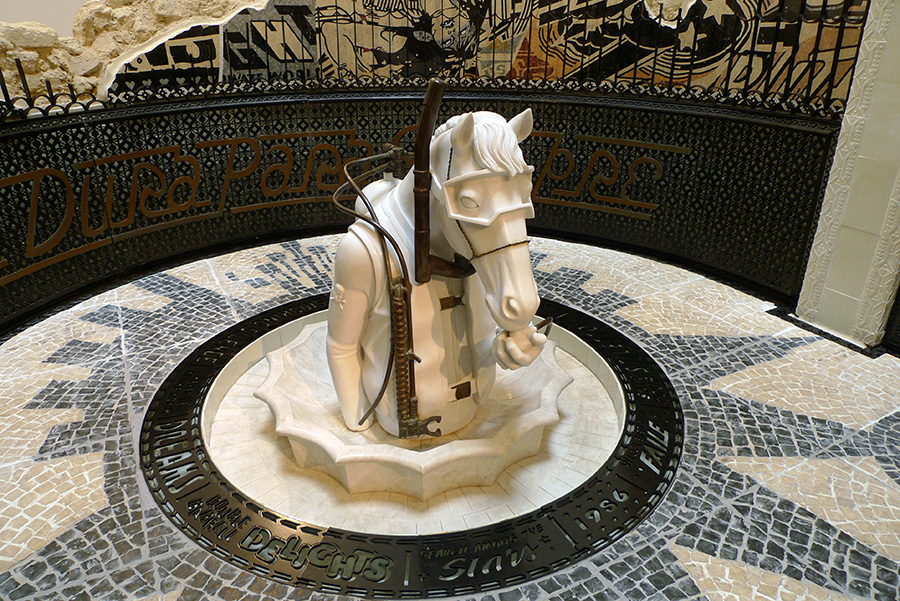
Two recent sculptures “Wolf Within” and “Fantasy Island” are monuments to youth culture – white, hipster youth culture. Not surprisingly, FAILE – Patrick McNeil and Patrick Miller are a couple white dudes based in Williamsburg.
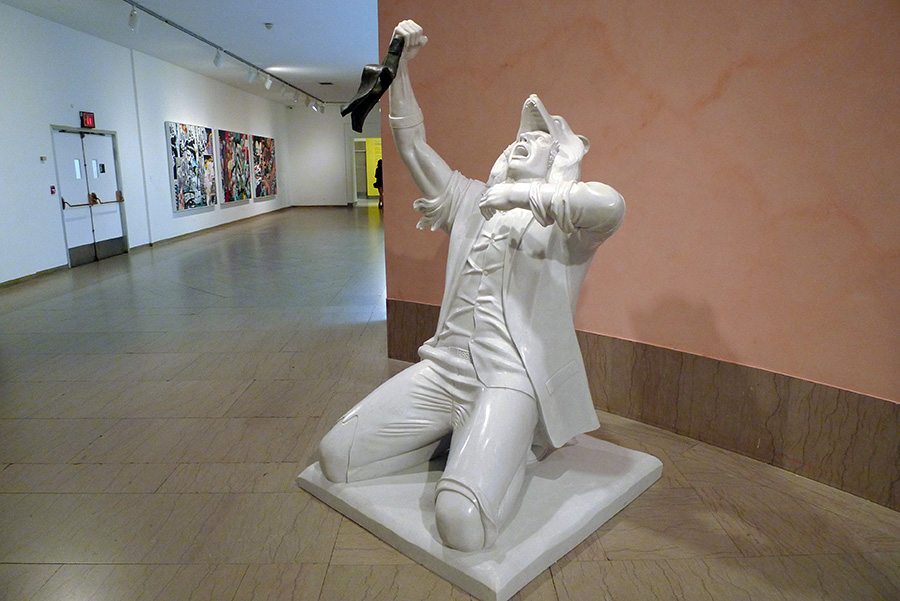
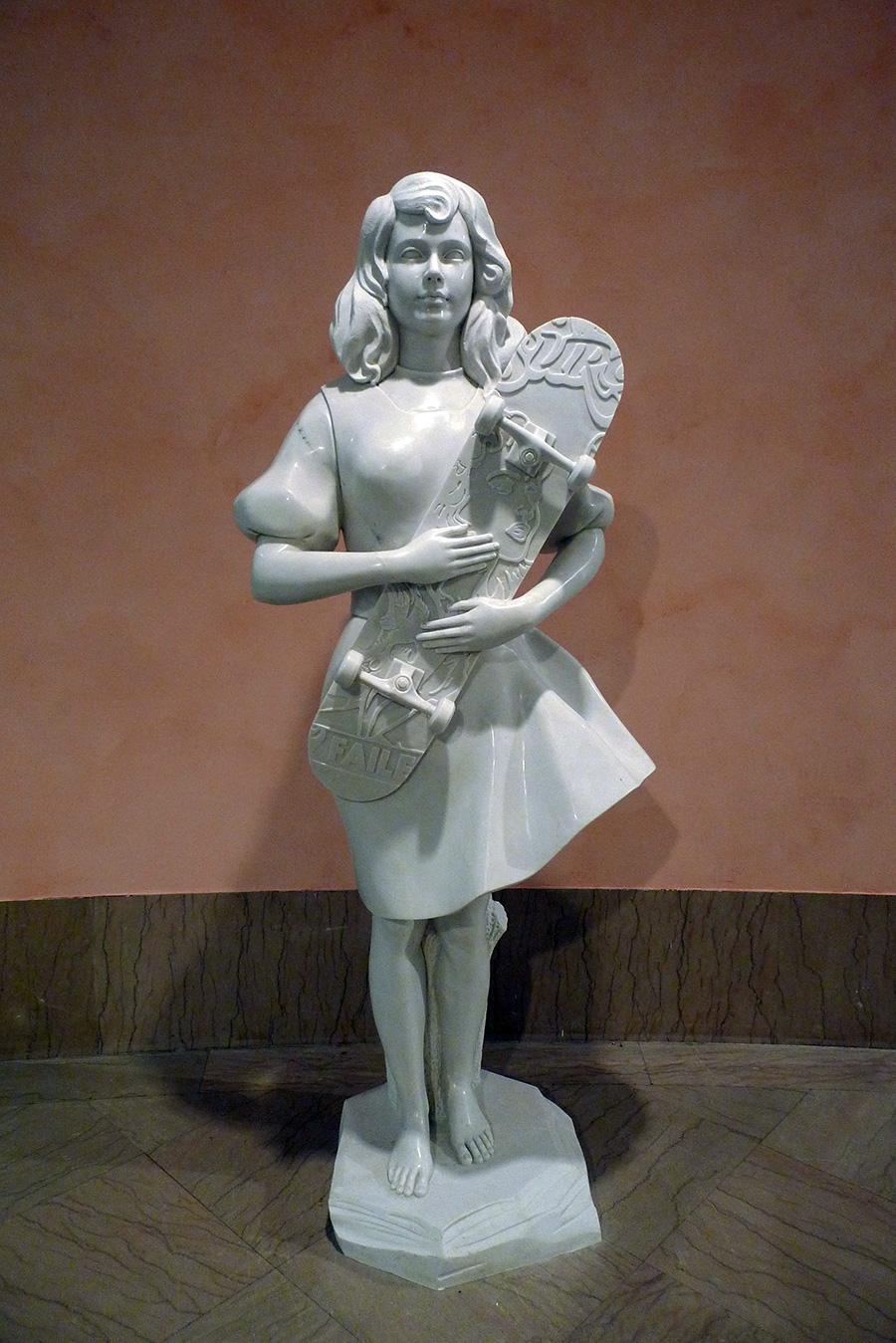
There is so much craft and attention to detail that I want the work to tell complex tails, but it is also such a cacophony of stuff that the work lacks an anchor, a base to reflect upon and allow me as a viewer to traverse. As soon as I start enjoying one tableau, I’m jolted by some kitsch material lifted from a 50’s movie poster or pulp book cover.
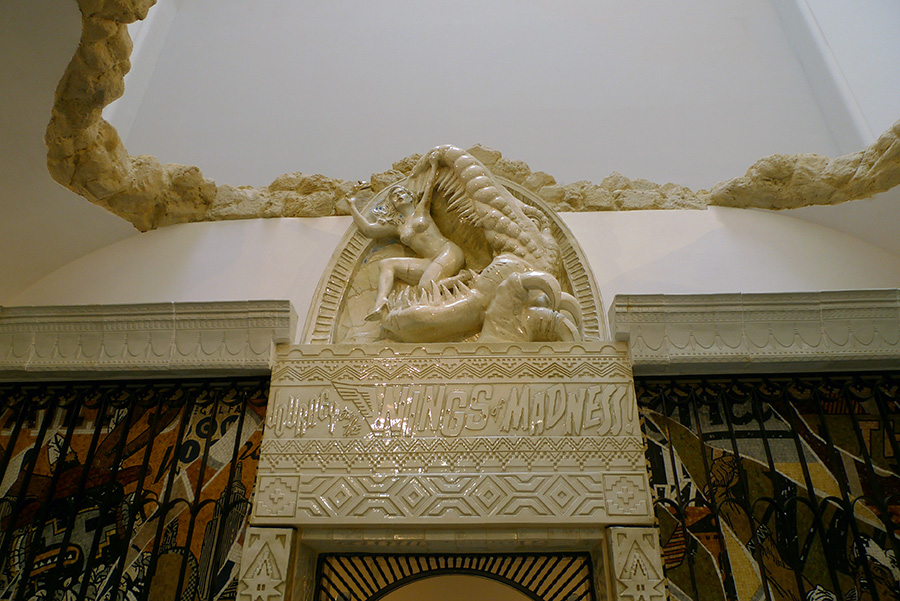
“Dictator Cycle” at Art Student League of Denver
My illustrated series of dictators is up at the Art Student League of Denver. The series has six dictator pairings from dictator to liberator or reformist turned dictator… Stalin/Putin, Somoza/Ortega, Idris/Gaddafi, Smith/Mugabe, Batista/Castro, Hirohito/Kim Il-sung with current day repercussions. Ah, the effects of power…



Adrián Villar Rojas at Moderna Museet
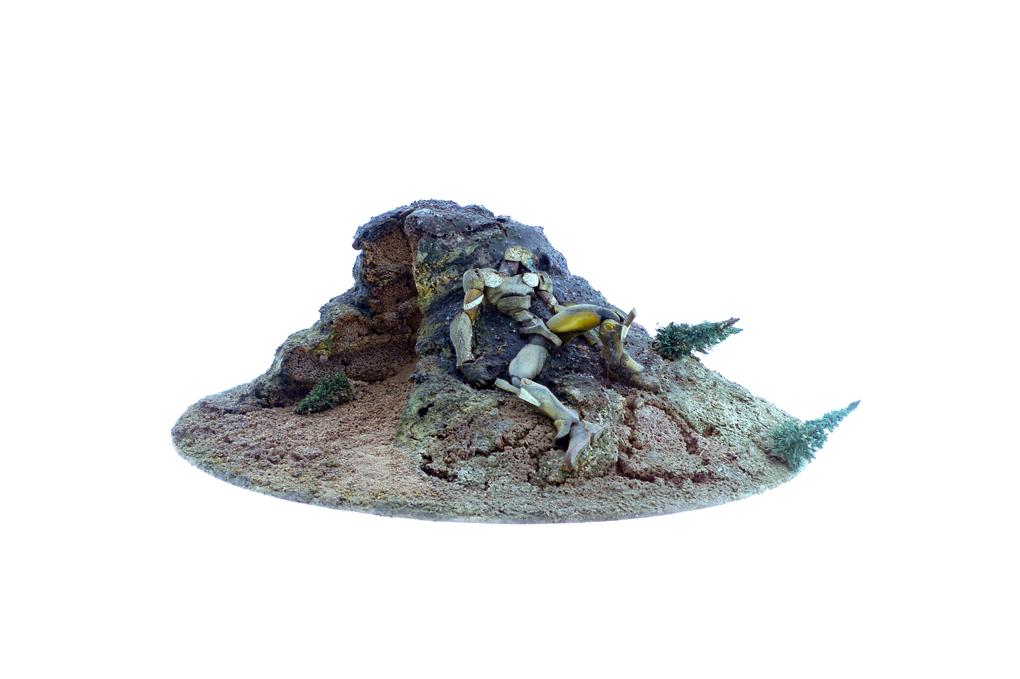
Adrián Villar Rojas at Moderna Museet in Stockholm
While seeing Adrián Villar Rojas’s “Fantasma” exhibition at Moderna Museet in Stockholm, I was immediately reminded of Gabriel Orozco. The work, the objects, the installation and presentation were a second coming of Orozco’s efforts, however, unfortunately much more affected.
With Orozco’s work, I tend to be presented with a sense of discovery by mistake or happenstance. Many of Orozco’s photographs document a visually engaging observation that is about to fade or capture a playful intervention. And the objects as well, may be found objects with slight interventions or playful ideas that have been produced at human scale. Although Villar Rojas’s objects harken to Orozco’s sculptures, they appear entirely artificial and do not have a sense of playful discovery. They seem entirely manipulated and in the end not very interesting or engaging.
I wish that the large installation of objects were all in the vein of the defeated Robotech diorama in the stark white space preceding the larger hall (pictured above). At least this piece has more fun with the Fine Art museum setting than the pretentious tall island of stuff in the main gallery.

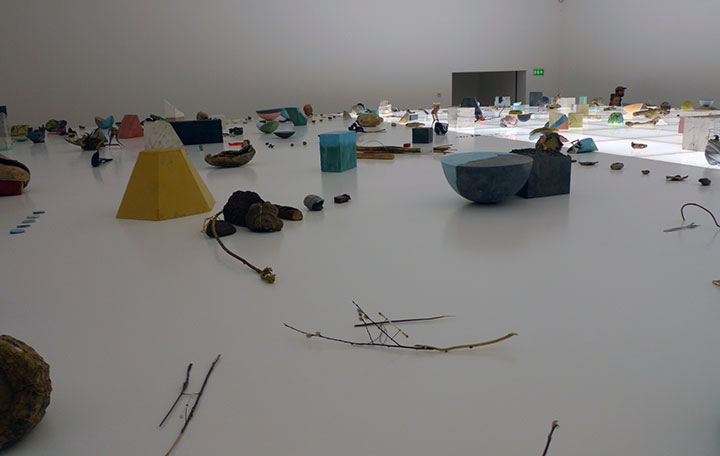
The museum presents an interview with Adrián Villar Rojas in which he unfortunately comes across as a bit pretentious. I’ll be surprised if this work is worth restoring and preserving.
Art in Copenhagen’s Meat Packing District
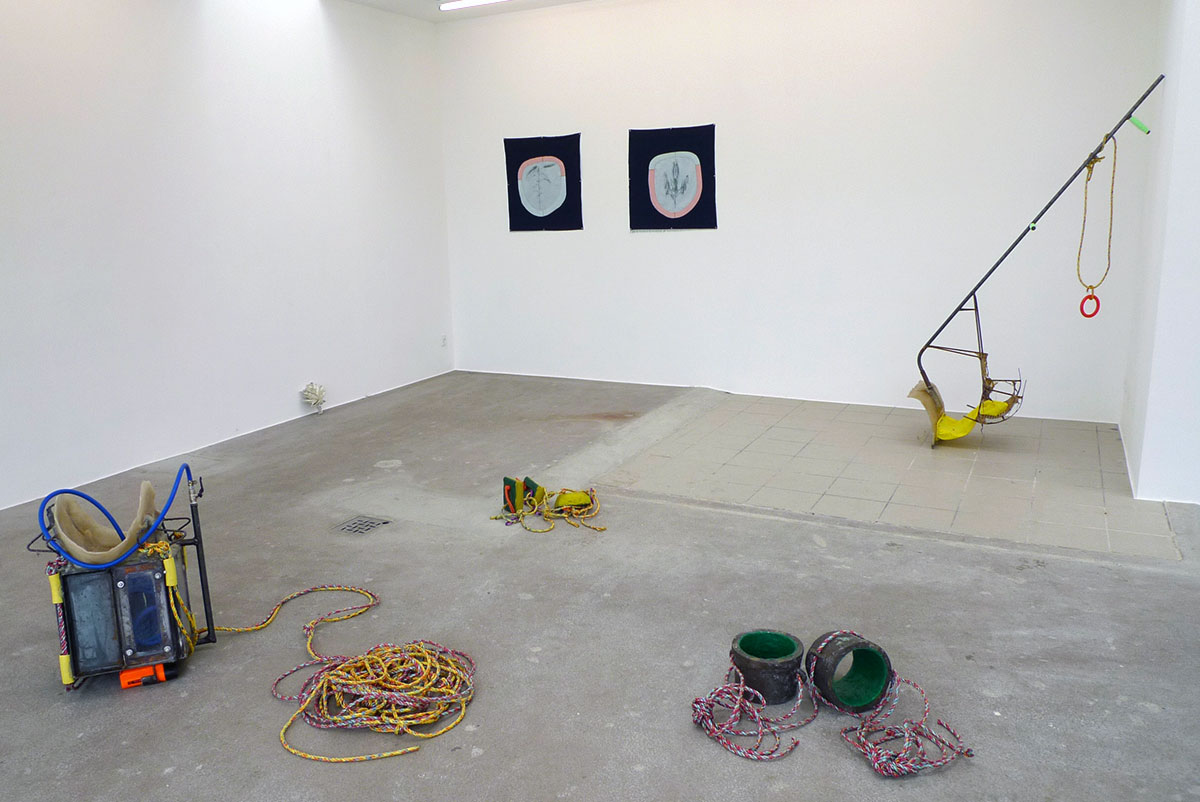
Sculptures by Emil Toldbod at Gether Contemporary
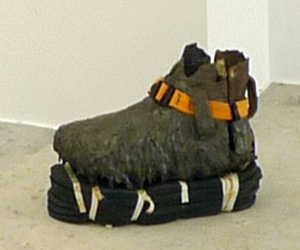 Gether Contemporary’s “Beneath the Surface” features the work of five young artists from the Royal Danish Academy of Fine Arts; Esben Gyldenløve, Oskar Jakobsen, Christine Overvad, Emil Toldbod and Nicky Sparre Ulrich. The only work that caught my imagination were the mixed-media sculptures by Emil Toldbod that comprise a series titled “Second Dive: Entering Another World”. Apparently the sculptures are employed in a film in which he wears and uses the sculptures to walk the surface of the sea digging through it’s ground. Below is what I imaging to be a test video in which he wears weighted boots to try and walk along the bottom of a swimming pool. The shoes in the video are pictured to the left.
Gether Contemporary’s “Beneath the Surface” features the work of five young artists from the Royal Danish Academy of Fine Arts; Esben Gyldenløve, Oskar Jakobsen, Christine Overvad, Emil Toldbod and Nicky Sparre Ulrich. The only work that caught my imagination were the mixed-media sculptures by Emil Toldbod that comprise a series titled “Second Dive: Entering Another World”. Apparently the sculptures are employed in a film in which he wears and uses the sculptures to walk the surface of the sea digging through it’s ground. Below is what I imaging to be a test video in which he wears weighted boots to try and walk along the bottom of a swimming pool. The shoes in the video are pictured to the left.
At the bottom left of the image is a helmet that Emil wears in his film and to the right is a shovel that he pushes along the sea’s bottom. To the right of the helmet, are concrete rings that he wears on his thighs and in the back concrete weights that he drags along to help him remain below the water surface. The sculptures immediately brought to mind the literary genre Speculative Fiction as the artist crafted survival tools from found objects to allow him to trove the bottom of the sea after the waters have risen over much of the continents. These are make-shift tools assembled and crafted by impoverished survivors of a not so distant future that will help them continue living from the debris of past civilization. As I know nothing about the film or “Second Dive: Entering Another World” other than seeing a few sculptures on view at Gether Contemporary and a still on the Gether site, I’m just making all this up in contemplating Emil Toldbod’s work.
1. Første skridt i min søgen efter det omvendt drejede sneglehus. from Emil Toldbod on Vimeo.
Above Gether Contemporary in Copenhagen’s Meat Packing district is Galleri Bo Bjeggard where I enjoyed the whimsical exhibition “Flowers for Poul” (PDF catalog for “Flowers of Poul”). “Flowers for Poul” celebrates the 90th birthday of deceased artist Poul Gernes by presenting the work of John Armleder, Cosima von Bonin, Paul Fagerskiold, Callum Innes, SUPERFLEX, Janaina Tscape and Eriwn Wurm as well as work by Poul Gernes. Flowers for Poul The exhibition is beautifully installed and visually engaging as large colorful works keep the viewer engaged from room to room. The works that stood out to me are SUPERFLEX’s “Information Machine” and “Commons Machine”. Although these pieces are simple and don’t function very well, particularly the make shift tops of “Information Machine” the pieces allow for simple interactivity that inanely reflect on our networked society.
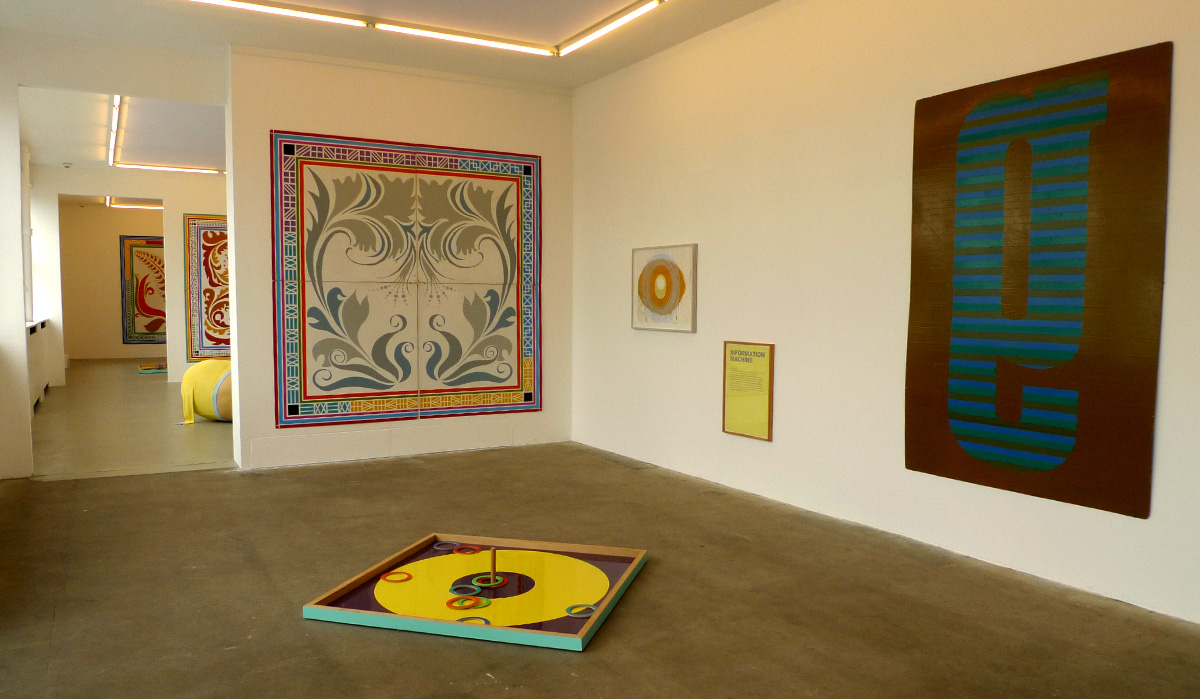
SUPERFLEX’S “INFORMATION MACHINE” “models the struggle between the desire to share information and the desire to contain information. Player A (represents the desire to share information) plays against Player B (represented by the pole in the middle) to choose between sharing information or containing information. The player with the most rings on the pole wins. If there are no rings on the pole the people do not have to choose between sharing information or containing information. The game is endless.” As described by SUPERFLEX, the players are our desire to share as well as contain information and their goal is to have us engage.
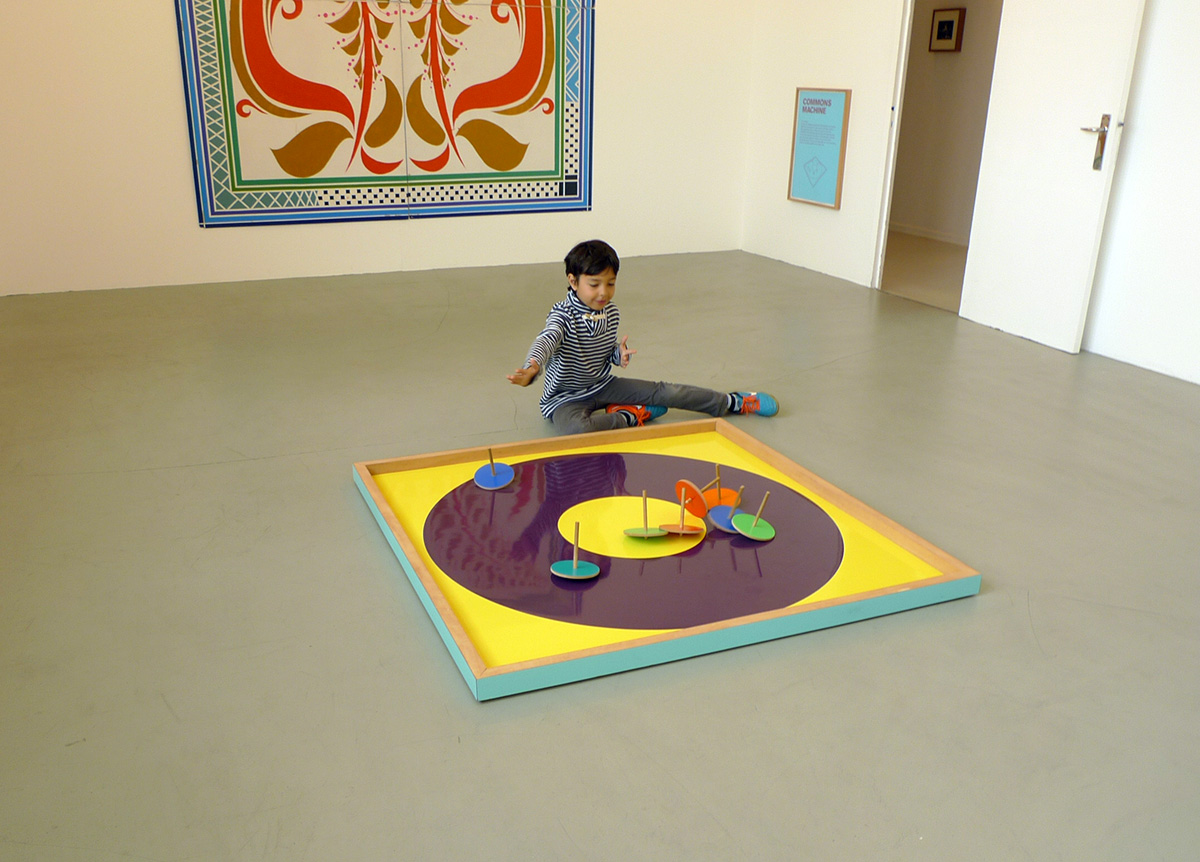
COMMONS MACHINE, I would enjoy a lot more if the tops actually worked. Built for 2-10 players acting as “software programmers are working together to develop an open-source system. The programmers are contributing by launching their SPINNING TOPs with open source codes (the spinning top). The source code must not end up in the proprietary domain area (the yellow area) but remain in the common area (the purple area). If any source code ends up in the proprietary area, the operating system is no longer free.” Unfortunately, the tops don’t really spin, it’s art.
From Bo Bjerggaard we walked over to V1 Contemporary Art Center which featured the art of two artists who began their careers as grafiti and tag artists in the Eighties – Barry McGee and Todd James. Their work is well documented and critiques, so I’m only including a few images more so for my own visual archive. I love Barry McGee’s patterns and the simplicity of Todd James’s fantasy drawings in his zine “Beyond the Gates” of viking-like warrior women.
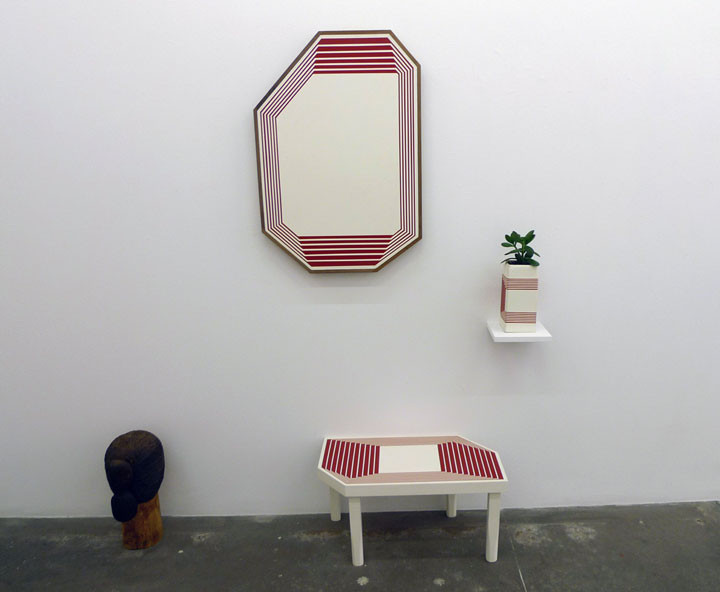
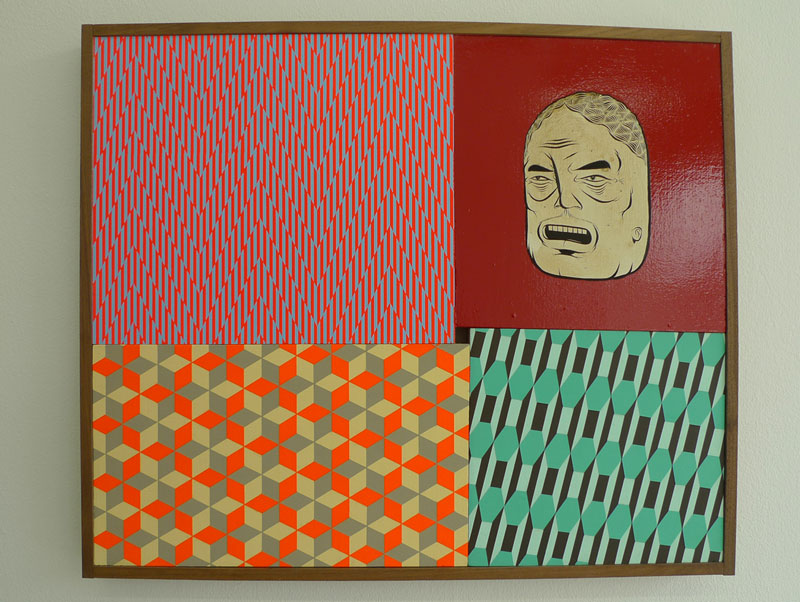
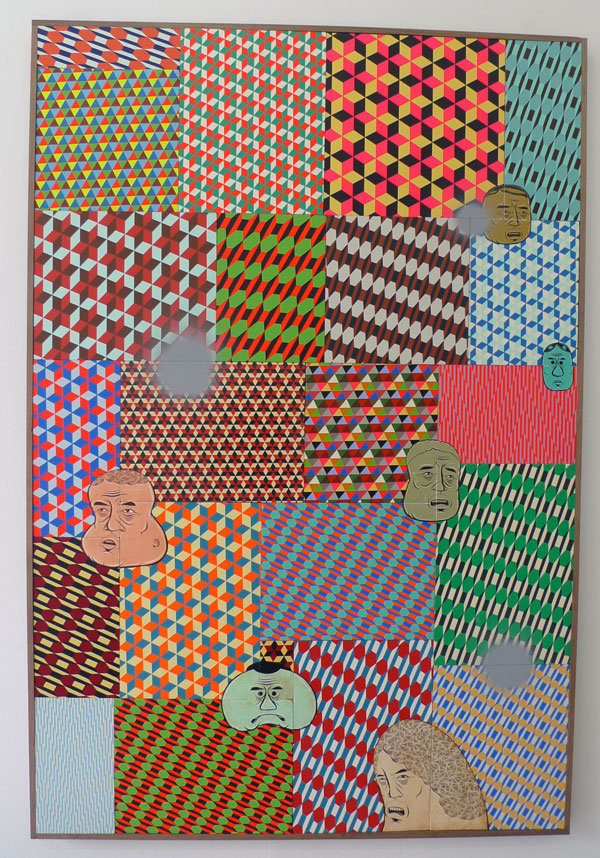
Todd James’s drawings are powerful in their printed comic format, I do not find the paintings at all interesting.
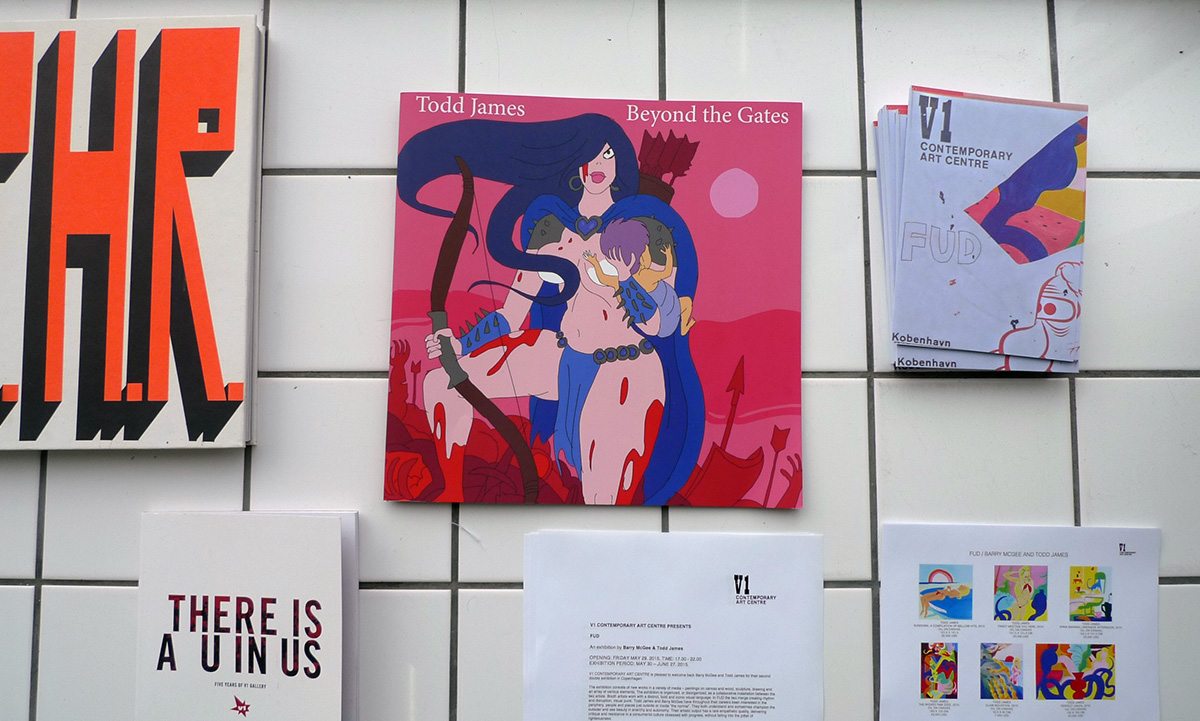
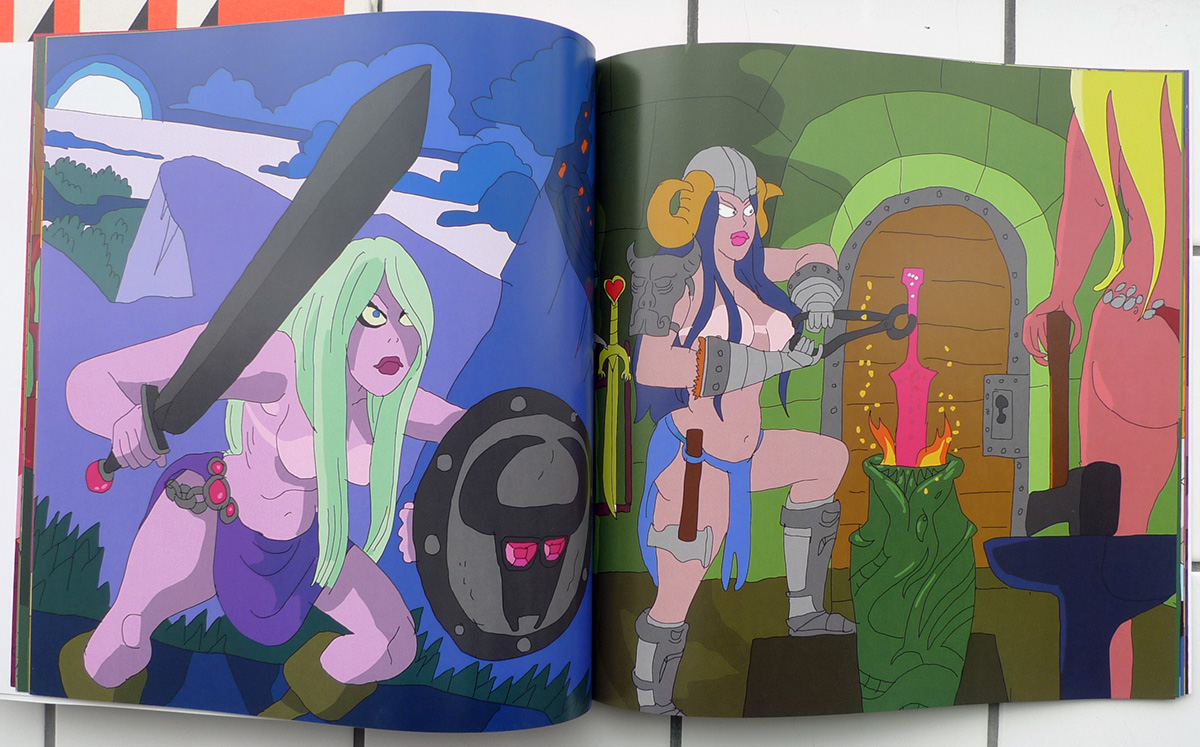
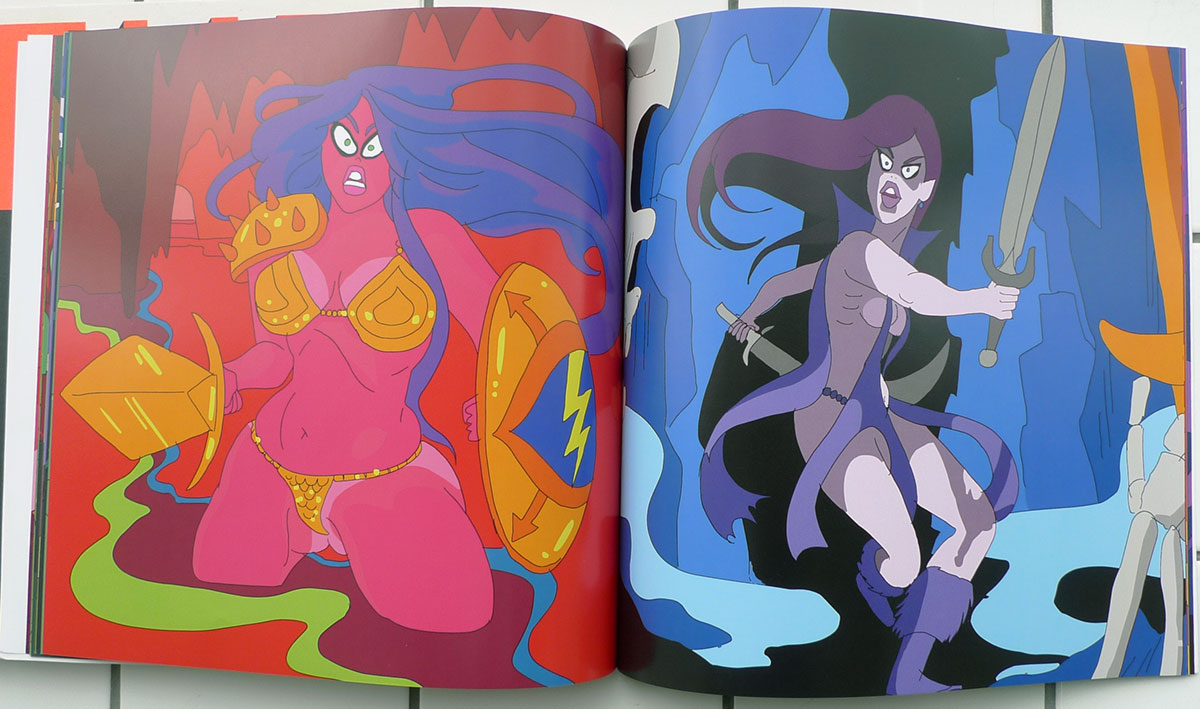
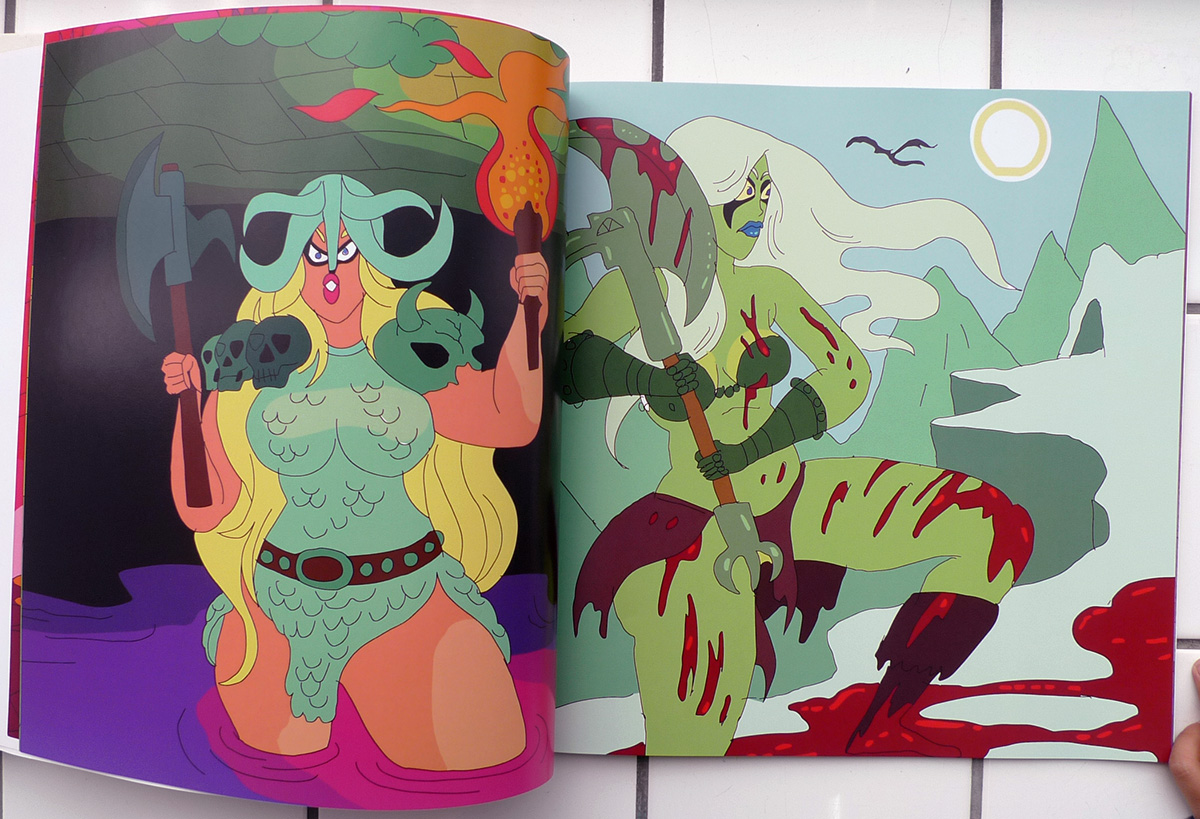
Boring…
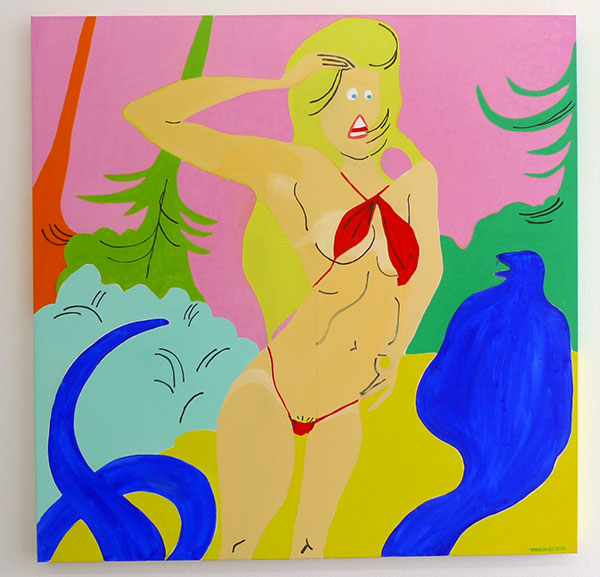
“Drifting in Daylight” at Harlem Meer
After getting lost in beautifully tucked away trails toward the north west corner of Central Park, the discovery of the S.S. Hangover made for successful end of art hunting in Central Park this past Saturday. The only one disappointed in our group of six art viewers was the 5 year old who had envisioned riding the boat along the lake as the music played. Fortunately the soft pleasant music performed from the boat by the brass sextet calmed our disillusioned interactive art connoisseur.
Upon studying the ship, my 6 year old immediately asked why there was a fat unicorn on the sail. A Creative Time attendant, corrected him that it was not a unicorn, but the winged horse, Pegasus from the myth of Hercules. To everyone’s disappointment, she went on to explain that the fat Pegasus represents the struggling artist who has gotten older and is unable to achieve artistic recognition and glory. I immediately wondered why the artist had to take a nice performative piece and stamp it with such a trite concept.
The boat appeared to circle around a small island as it performed a piece by Kjartan Sveinsson. We only remained for iterations that were relaxing and pleasant. As we continued to walk around the Harlem Meer, we encountered Karyn Olivier’s “Here and Now/Glacier, Shard, Rock” – a lenticular signboard that shifts between photographs of the immediate environment behind the billboard, a glacier and pottery shard that resembled a Western classical pottery work.
Upon exiting Harlem Meer and Central Park on the east side, we encountered Spencer Finch’s “Sunset (Central Park)” – a soft-serve ice cream truck that employs solar panels to cool and power the soft-swerve. The line for the free ice-cream was far too long for us to experience the solar-cooled ice cream.
Overall the work that we encountered was poetic and relaxing at a time when so much of the immediate social issues carry friction, stress and the growing schism between the rich and poor on our earth.